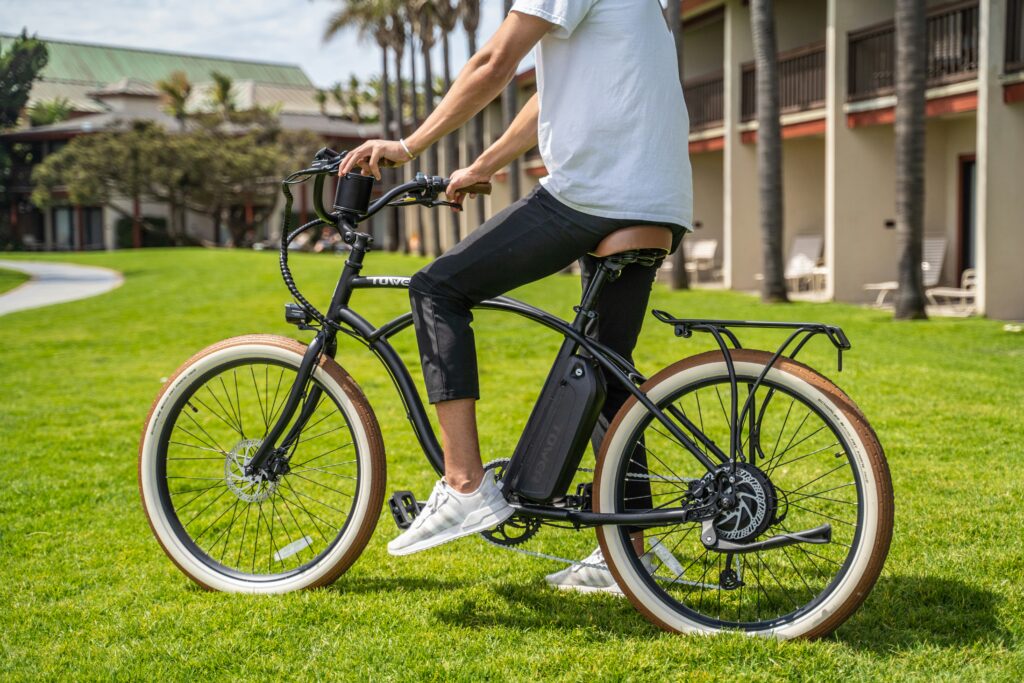Are you ready to embark on an electrifying adventure? In this article, we will guide you through the exhilarating world of electric bike riding. From mastering the art of balancing to navigating the streets with ease, we’ve got you covered. Whether you’re a beginner or a seasoned cyclist, this comprehensive guide will equip you with all the knowledge and tips you need to ride an electric bike like a pro. Get ready to feel the wind in your hair and the thrill of effortless pedaling as we unveil the secrets to a smooth and enjoyable electric bike ride. Let’s pedal into the future together!

Choosing the Right Electric Bike
When it comes to choosing the right electric bike for your needs, there are a few factors to consider. First and foremost, you need to think about your riding needs. Are you planning on using the electric bike for your daily commute or for leisurely rides on the weekends? Are you going to be riding on paved roads or off-road trails? Understanding how you plan to use the bike will help you determine what features and specifications to look for.
Next, it’s important to determine your budget. Electric bikes come in a wide range of prices, so it’s important to have a clear idea of how much you’re willing to spend. Consider not only the upfront cost of the bike, but also any ongoing maintenance and potential upgrades you may need in the future.
Once you have a clear understanding of your riding needs and budget, it’s time to research different electric bike models. Look for bikes that have the features you need, such as a long battery life, a powerful motor, and sturdy construction. Read reviews from other riders to get a sense of their experiences with different models. This research phase is crucial in finding the electric bike that is perfect for you.
Before making your final decision, it’s highly recommended to test ride the electric bike before purchasing. This will allow you to get a feel for how comfortable and responsive the bike is, and whether it meets your expectations. Many bike shops offer test rides, so take advantage of this opportunity to ensure that the bike is the right fit for you.
Understanding the Electric Bike Components
To effectively ride an electric bike, it’s important to have a basic understanding of its components. Let’s take a look at some key components that make up an electric bike:
Battery
The battery is what powers the electric bike. It stores the electrical energy that is used to drive the motor and assist your pedaling. When choosing an electric bike, consider the battery’s capacity and range, as well as the charging time.
Motor
The motor is what propels the bike forward. Electric bikes can have different types of motors, such as hub motors or mid-drive motors. The motor’s power and efficiency will affect the bike’s performance and overall riding experience.
Throttle or Pedal Assist
Electric bikes can either have a throttle or pedal assist system, or sometimes both. A throttle allows you to control the bike’s speed with a simple twist of the handlebar, while pedal assist provides motor assistance when you pedal. Understanding how these systems work is important for controlling the bike’s speed and power.
Brakes
Just like any other bike, electric bikes are equipped with brakes to help you stop safely. There are different types of brakes, such as disc brakes or rim brakes. Understanding how to use the brakes properly and maintaining their functionality is crucial for your safety.
Gears
Some electric bikes come with gears, similar to traditional bicycles. Gears can help you adjust the bike’s resistance and make pedaling easier or harder depending on the terrain. Familiarize yourself with the gears and learn how to shift properly for a smoother riding experience.
Frame
The frame is the main structure of the electric bike. It provides stability and support for all the other components. Ensure that the frame is sturdy and durable, especially if you plan on riding off-road or on uneven terrain. A well-built frame can greatly enhance your riding experience and ensure your safety.
Preparing for the Ride
Before hopping on your electric bike, there are a few important steps to take to ensure a smooth and enjoyable ride:
Check the battery level
Make sure that your electric bike’s battery is charged before heading out. You don’t want to be stranded with a dead battery halfway through your ride. It’s also a good idea to carry a charger with you, just in case you need to top up the battery along the way.
Adjust the seat height
Proper seat height is essential for comfort and efficient pedaling. Adjust the seat to a height that allows a slight bend in your knees when your foot is on the pedal at its lowest point. This will help prevent strain on your knees and optimize your pedaling efficiency.
Familiarize yourself with the controls
Take a moment to familiarize yourself with the electric bike’s controls, including the throttle or pedal assist system, brakes, and gear shifters if applicable. Ensure that you understand how to operate each control properly before setting off.
Put on safety gear
Safety should always be a top priority when riding any kind of bike. Put on a properly fitted helmet to protect your head in case of a fall. Additionally, consider wearing reflective clothing and using lights to make yourself more visible to other road users, especially if you plan on riding in low light conditions.
Mounting and Dismounting an Electric Bike
Mounting and dismounting an electric bike may seem simple, but there are some important steps to follow to ensure your safety:
Approaching the bike
Approach the bike from the side, standing with your feet shoulder-width apart. This will give you stability as you prepare to mount the bike.
Positioning the bike
Hold the handlebars with a relaxed grip and position the bike between your legs. Ensure that the bike is upright and balanced before attempting to mount.
Mounting the bike
Swing your leg over the bike and gently lower yourself onto the seat. Keep your weight centered and balanced as you settle onto the seat.
Dismounting the bike
When it’s time to get off the bike, come to a complete stop and put one foot on the ground for stability. Swing your other leg over the bike and dismount in a controlled manner, ensuring both feet are firmly on the ground before letting go of the bike.

Starting and Stopping
Once you’re mounted on your electric bike, it’s time to learn how to start and stop effectively:
Starting the electric bike
To start the electric bike, make sure the throttle or pedal assist system is engaged, and start pedaling or twist the throttle gently. Gradually increase your speed and find a comfortable pace.
Using the throttle or pedal assist
If your electric bike has a throttle, it allows you to control the speed without pedaling. However, using the pedal assist system is generally more efficient and helps conserve battery power. Experiment with both options to see which suits your riding style best.
Braking and stopping safely
When coming to a stop, gently apply the brakes evenly to avoid sudden jerks or skidding. Remember to release the throttle or stop pedaling when you want to slow down or stop completely. Practice braking gradually to maintain control and stability.
Maintaining Balance and Stability
Maintaining balance and stability while riding an electric bike is essential for a safe and enjoyable experience. Here are some tips to help you stay balanced on your ride:
Keeping a relaxed posture
Keep your body relaxed and avoid tensing up. Maintain a natural and upright posture, with your back straight and your arms slightly bent. Relaxing your grip on the handlebars will help absorb any shocks or vibrations from the road.
Maintaining an even weight distribution
Distribute your weight evenly between the pedals and the seat. Avoid leaning too far forward or backward, as this can affect your balance and control of the bike. Make sure your body is centered and aligned with the bike’s frame.
Applying countersteering technique
To steer the bike effectively, understand the concept of countersteering. When approaching a turn, gently push on the handlebar in the opposite direction you want to go. This initiates the lean of the bike, allowing you to navigate turns more smoothly and efficiently.
Handling turns and curves
Approaching turns and curves with caution is important to maintain stability. Slow down before entering the turn and lean your body and bike slightly in the direction of the curve. Always look ahead and keep your eyes on the path you want to follow.

Riding Safety Tips
Safety should be your top priority when riding an electric bike. Here are some important safety tips to keep in mind:
Stay alert and aware of your surroundings
Always be mindful of your surroundings and anticipate potential hazards. Scan the road ahead and stay vigilant for any obstacles or upcoming traffic. Avoid distractions such as using your phone while riding.
Obey traffic rules and regulations
Follow all traffic rules, signals, and signs, just like you would when driving a car or riding a traditional bike. Signal your turns, stop at red lights, and yield to pedestrians. Respecting traffic laws helps ensure your safety and the safety of others.
Use hand signals to communicate
Use hand signals to indicate your intentions to other road users. Raise your left arm to signal a left turn, your right arm to signal a right turn, and use your hand pointing downward to signal stopping or slowing down.
Watch out for road hazards
Be on the lookout for potential road hazards such as potholes, gravel, or debris. Avoid them whenever possible, and if you can’t, slow down and navigate them with caution. Pay attention to changes in road conditions to maintain stability.
Stay visible with proper lighting and reflectors
Make yourself visible to others, especially when riding at night or in low light conditions. Equip your electric bike with front and rear lights, as well as reflectors on both the bike and your clothing. This will help drivers and pedestrians see you more easily.
Keep a safe distance from vehicles
Maintain a safe distance from vehicles on the road, especially when riding in traffic. Give yourself enough time and space to react to any sudden stops or changes in traffic flow. Remember, you have less protection than a car, so it’s important to be cautious.
Gaining Confidence and Skill
Building confidence and skill in riding an electric bike takes practice and experience. Here are some steps to help you gain confidence and improve your riding skills:
Start with short and familiar routes
Begin by riding in a safe and familiar environment, such as your neighborhood or a local park. Start with short rides to get comfortable with operating the electric bike and gradually increase the distance as you gain confidence.
Practice different maneuvers
Set aside time to practice different maneuvers, such as turning, stopping, and starting. Find an open space or empty parking lot where you can practice these skills without any distractions or hazards.
Gradually increase speed and distance
As your skills and confidence improve, start increasing your speed and distance. Gradually challenge yourself by taking longer rides and pushing yourself to ride at higher speeds. Remember to always ride within your comfort level and capabilities.
Take an electric biking course
Consider taking an electric biking course to further enhance your skills and knowledge. These courses cover topics such as safety, maintenance, and advanced riding techniques. They are a great way to learn from experienced instructors and interact with other electric bike enthusiasts.

Charging and Battery Maintenance
To keep your electric bike running smoothly, it’s important to understand how to charge and maintain the battery:
Using the correct charger
Always use the charger that is specifically designed for your electric bike’s battery. Using a different charger could potentially damage the battery or cause it to malfunction.
Plugging in the battery
Follow the manufacturer’s instructions for properly plugging in the battery to the charger. Ensure that the connection is secure and that the charger is plugged into a reliable power source.
Charging time and duration
The charging time and duration can vary depending on the battery capacity and charger specifications. Keep an eye on the charging progress and avoid overcharging the battery, as this can reduce its overall lifespan.
Storing the battery properly
If you’re not using your electric bike for an extended period, it’s important to store the battery correctly. Keep it in a cool and dry place, away from extreme temperatures and direct sunlight. Some manufacturers recommend partially charging the battery before long-term storage.
Replacing or upgrading the battery
Over time, the battery’s capacity may decrease, reducing your electric bike’s range. If you notice a significant decrease in performance, it may be time to consider replacing or upgrading the battery. Consult the manufacturer or a professional bike technician for guidance.
Troubleshooting Common Issues
Even with proper maintenance, you may encounter some common issues with your electric bike. Here are some troubleshooting tips to help address these problems:
Dealing with a flat tire
If you get a flat tire, you have a few options. You can attempt to patch or replace the inner tube yourself if you have the necessary tools and knowledge. Alternatively, you can take the bike to a bike shop for professional assistance. It’s always a good idea to carry a spare tube or a patch kit when riding.
Fixing common mechanical problems
If you experience mechanical issues such as a loose chain or a misaligned derailleur, consult your bike’s user manual or seek professional help. Attempting to fix these issues without the proper knowledge can potentially cause further damage.
Addressing battery-related concerns
If you notice a decrease in battery performance or any other battery-related concerns, consult the manufacturer’s instructions or contact their customer support. They will be able to provide guidance and troubleshoot any issues you may be experiencing.
Finding professional assistance
If you encounter any other issues that you’re unable to resolve on your own, don’t hesitate to seek professional assistance. A bike shop or an electric bike technician will have the knowledge and expertise to diagnose and fix any problems you may be facing.
Riding an electric bike can be a fun and efficient way to get around. By choosing the right electric bike, understanding its components, and practicing safe riding techniques, you can enjoy a comfortable and exhilarating ride. Remember to always prioritize safety, maintain your electric bike properly, and seek help when needed. Happy riding!


